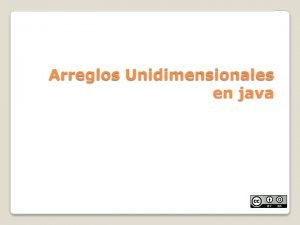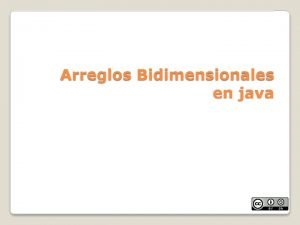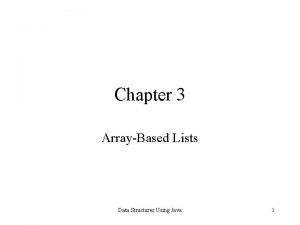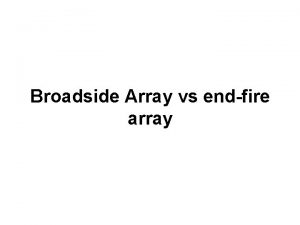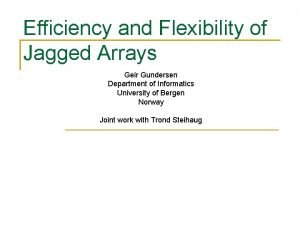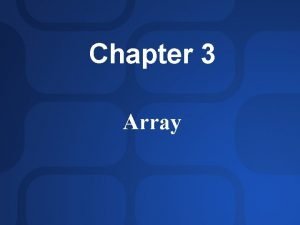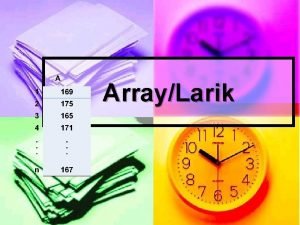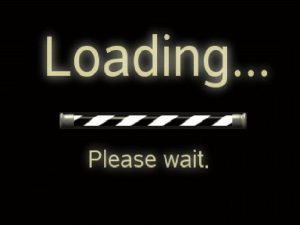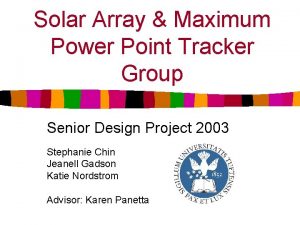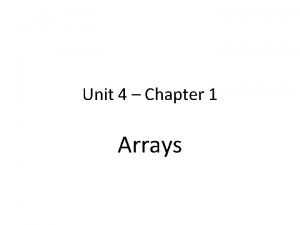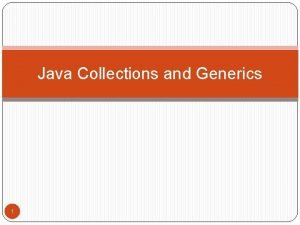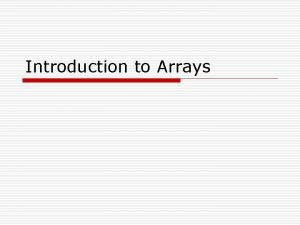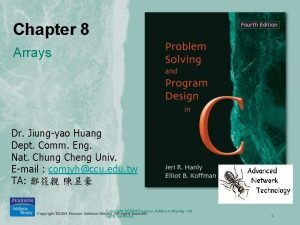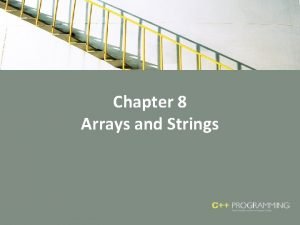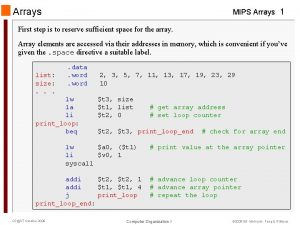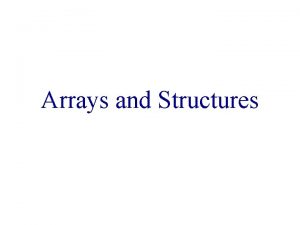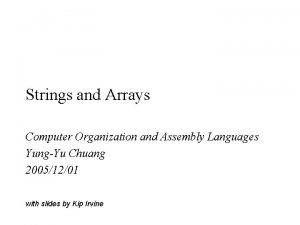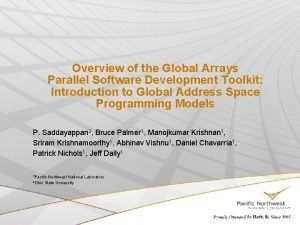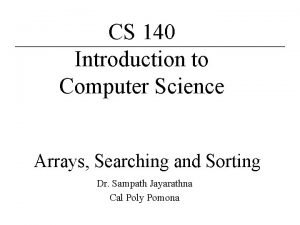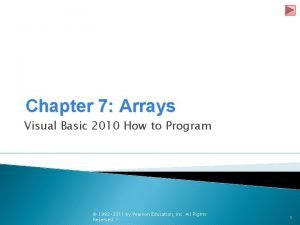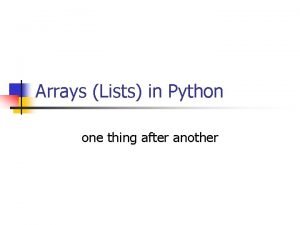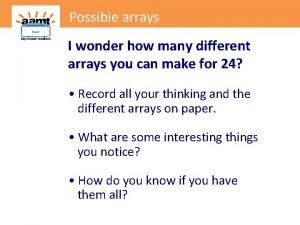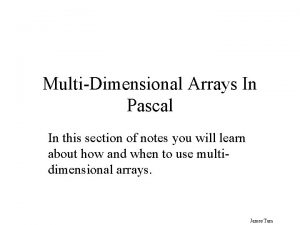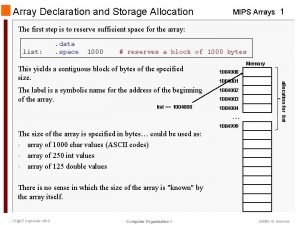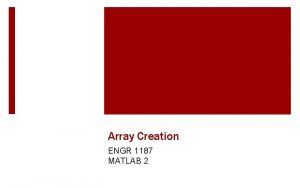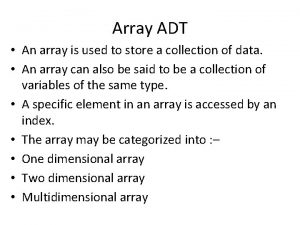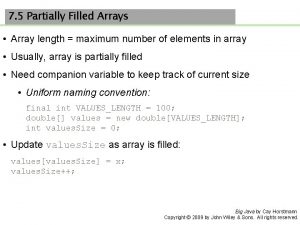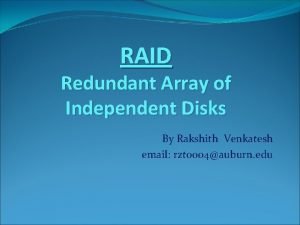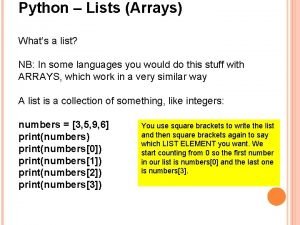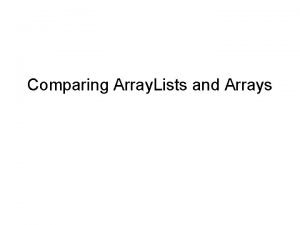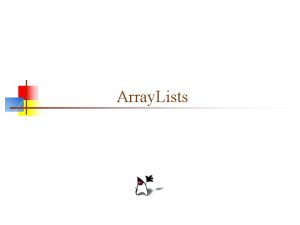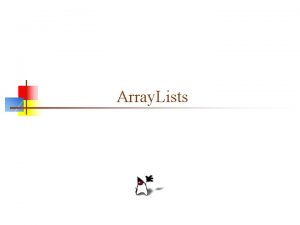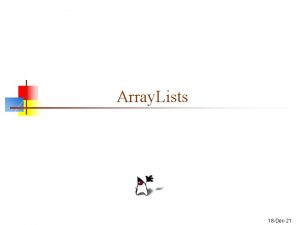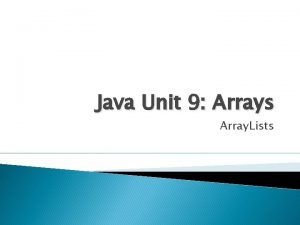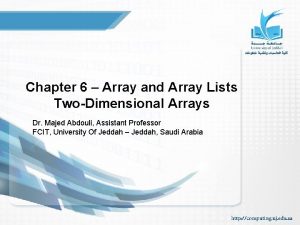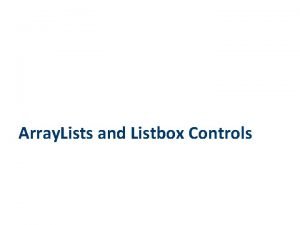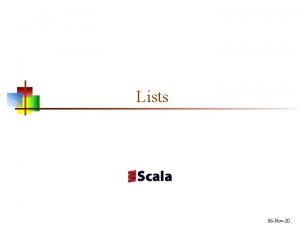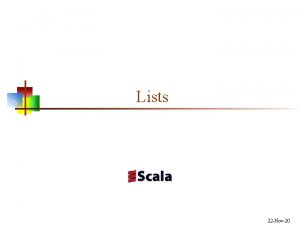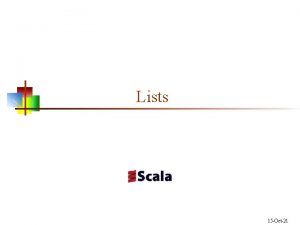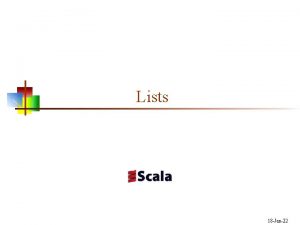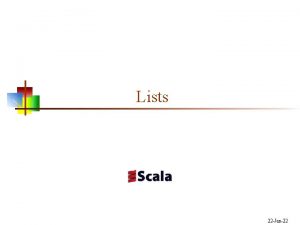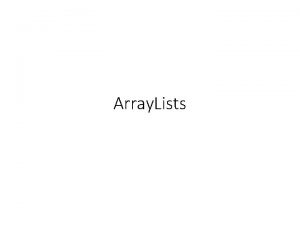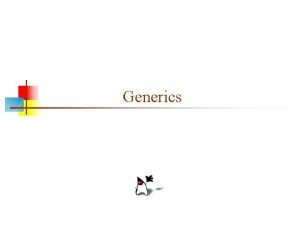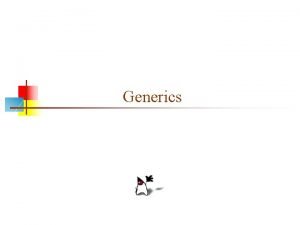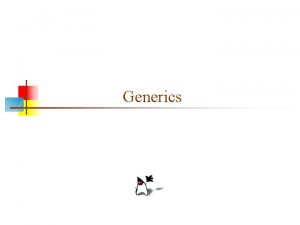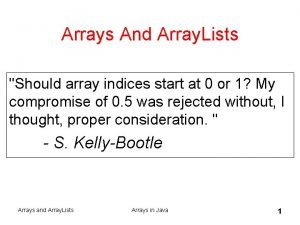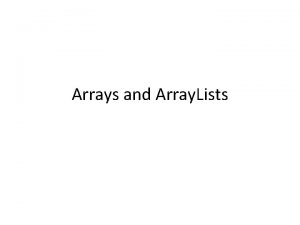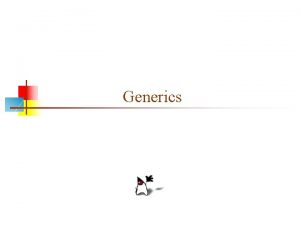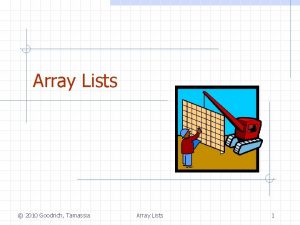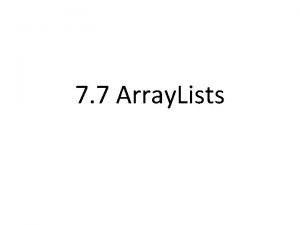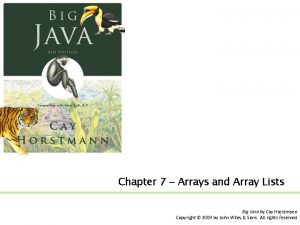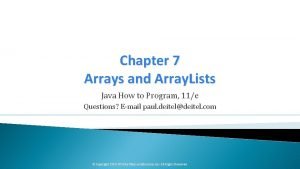Chapter 7 Arrays and Array Lists Java How





































- Slides: 37

Chapter 7 Arrays and Array. Lists Java™ How to Program, 9/e Presented by: Dr. José M. Reyes Álamo © Copyright 1992 -2012 by Pearson Education, Inc. All Rights Reserved.

7. 1 Introduction Data structures § Collections of related data items. Arrays § Data structures consisting of related data items of the same type. § Make it convenient to process related groups of values. § Remain the same length once they are created. Common array manipulations with static methods of class Arrays from the java. util package. Array. List collection § Similar to arrays § Dynamic resizing They automatically increase their size at execution time to accommodate additional elements © Copyright 1992 -2012 by Pearson Education, Inc. All Rights Reserved.

7. 4 Array Example © Copyright 1992 -2012 by Pearson Education, Inc. All Rights Reserved.

7. 13 Class Arrays class § Provides static methods for common array manipulations. Methods include § sort for sorting an array (ascending order by default) § binary. Search for searching a sorted array (need to sort it first) § equals for comparing arrays § fill for placing values into an array. Methods are overloaded for primitive-type arrays and for arrays of objects. System class static arraycopy method § Copies contents of one array into another. © Copyright 1992 -2012 by Pearson Education, Inc. All Rights Reserved.




7. 14 Introduction to Collections and Class Array. List Java API provides several predefined data structures, called collections, used to store groups of related objects. § Each provides efficient methods that organize, store and retrieve your data without requiring knowledge of how the data is being stored. § Reduce application-development time. Arrays do not automatically change their size at execution time to accommodate additional elements. Array. List<T> (package java. util) can dynamically change its size to accommodate more elements. § T is a placeholder for the type of element stored in the collection. § This is similar to specifying the type when declaring an array, except that only nonprimitive types can be used with these collection classes. Classes with this kind of placeholder that can be used with any type are called generic classes. © Copyright 1992 -2012 by Pearson Education, Inc. All Rights Reserved.


7. 14 Introduction to Collections and Class Array. List (Cont. ) Figure 7. 23 demonstrates some common Array. List capabilities. An Array. List’s capacity indicates how many items it can hold without growing. When the Array. List grows, it must create a larger internal array and copy each element to the new array. § This is a time-consuming operation. It would be inefficient for the Array. List to grow each time an element is added. § An Array. List grows only when an element is added and the number of elements is equal to the capacity—i. e. , there is no space for the new element. © Copyright 1992 -2012 by Pearson Education, Inc. All Rights Reserved.

7. 14 Introduction to Collections and Class Array. List (Cont. ) Method adds elements to the Array. List. § One-argument version appends its argument to the end of the Array. List. § Two-argument version inserts a new element at the specified position. § Collections indices start at zero. Method size returns the number of elements in the Array. List. Method get obtains the element at a specified index. Method remove deletes an element with a specific value. § An overloaded version of the method removes the element at the specified index. Method contains determines if an item is in the Array. List. © Copyright 1992 -2012 by Pearson Education, Inc. All Rights Reserved.




Chapter 20 Generic Collections Java How to Program, 9/e Instructor: José M. Reyes Álamo © Copyright 1992 -2012 by Pearson Education, Inc. All Rights Reserved.

20. 2 Collections Overview Java collections framework § prebuilt data structures § interfaces and methods for manipulating those data structures A collection is a data structure that can hold references to other objects. § Usually, collections contain references to objects that are all of the same type. Figure 20. 1 lists some of the interfaces of the collections framework. Package java. util. © Copyright 1992 -2012 by Pearson Education, Inc. All Rights Reserved.

© Copyright 1992 -2012 by Pearson Education, Inc. All Rights Reserved.

20. 3 Type-Wrapper Classes for Primitive Types Each primitive type has a corresponding type-wrapper class (in package java. lang). § Boolean, Byte, Character, Double, Float, Integer, Long and Short. Each type-wrapper class enables you to manipulate primitive-type values as objects. Collections cannot manipulate variables of primitive types. § They can manipulate objects of the type-wrapper classes, because every class ultimately derives from Object. © Copyright 1992 -2012 by Pearson Education, Inc. All Rights Reserved.

20. 3 Type-Wrapper Classes for Primitive Types (cont. ) Each of the numeric type-wrapper classes—Byte, Short, Integer, Long, Float and Double— extends class Number. The type-wrapper classes are final classes, so you cannot extend them. Primitive types do not have methods, so the methods related to a primitive type are located in the corresponding type-wrapper class. © Copyright 1992 -2012 by Pearson Education, Inc. All Rights Reserved.

20. 4 Autoboxing and Auto-Unboxing A boxing conversion converts a value of a primitive type to an object of the corresponding type-wrapper class. An unboxing conversion converts an object of a type-wrapper class to a value of the corresponding primitive type. These conversions can be performed automatically (called autoboxing and auto-unboxing). Example: § // create integer. Array Integer[] integer. Array = new Integer[ 5 ]; // assign Integer 10 to integer. Array[ 0 ] = 10; // get int value of Integer int value = integer. Array[ 0 ]; © Copyright 1992 -2012 by Pearson Education, Inc. All Rights Reserved.

20. 5 Interface Collection and Class Collections Interface Collection is the root interface from which interfaces Set, Queue and List are derived. Interface Collection contains bulk operations for adding, clearing and comparing objects in a collection. A Collection can be converted to an array. Class Collections provides static methods that search, sort and perform other operations on collections. © Copyright 1992 -2012 by Pearson Education, Inc. All Rights Reserved.

20. 6 Lists A List (sometimes called a sequence) is a Collection that can contain duplicate elements. List indices are zero based. List also provides methods for manipulating elements via their indices, manipulating a specified range of elements, and searching for elements. Interface List is implemented by several classes, including Array. List, Linked. List and Vector. © Copyright 1992 -2012 by Pearson Education, Inc. All Rights Reserved.

20. 6. 2 Linked. List method add. All appends all elements of a collection to the end of a List. String method to. Upper. Case gets an uppercase version of a String method to. Lower. Case returns a lowercase version of a String. List method sub. List obtains a portion of a List. § This is a so-called range-view method, which enables the program to view a portion of the list. © Copyright 1992 -2012 by Pearson Education, Inc. All Rights Reserved.

20. 6. 2 Linked. List (cont. ) List method clear remove the elements of a List method size returns the number of items in the List. Linked. List method add. Last adds an element to the end of a List. Linked. List method add also adds an element to the end of a List. Linked. List method add. First adds an element to the beginning of a List. © Copyright 1992 -2012 by Pearson Education, Inc. All Rights Reserved.

20. 7 Collections Methods Class Collections provides several highperformance algorithms for manipulating collection elements. The algorithms (Fig. 20. 5) are implemented as static methods. © Copyright 1992 -2012 by Pearson Education, Inc. All Rights Reserved.

© Copyright 1992 -2012 by Pearson Education, Inc. All Rights Reserved.

© Copyright 1992 -2012 by Pearson Education, Inc. All Rights Reserved.

20. 7. 4 Method binary. Search static Collections method binary. Search locates an object in a List. § If the object is found, its index is returned. § If the object is not found, binary. Search returns a negative value. § Method binary. Search determines this negative value by first calculating the insertion point and making its sign negative. § Then, binary. Search subtracts 1 from the insertion point to obtain the return value, which guarantees that method binary. Search returns positive numbers (>= 0) if and only if the object is found. § List MUST be sorted binary. Search to work. © Copyright 1992 -2012 by Pearson Education, Inc. All Rights Reserved.

20. 8 Stack Class of Package java. util Class Stack in the Java utilities package (java. util) extends class Vector to implement a stack data structure. Stack method push adds an element to the top of the stack. Stack method pop removes the top element of the stack. § If there are no elements in the Stack, method pop throws an Empty. Stack. Exception, which terminates the loop. Method peek returns the top element of the stack without popping the element off the stack. Method is. Empty determines whether the stack is empty. © Copyright 1992 -2012 by Pearson Education, Inc. All Rights Reserved.

Stack Example © Copyright 1992 -2012 by Pearson Education, Inc. All Rights Reserved.

20. 9 Class Priority. Queue and Interface Queue extends interface Collection and provides additional operations for inserting, removing and inspecting elements in a queue. Priority. Queue orders elements by their natural ordering. § Elements are inserted in priority order such that the highest-priority element (i. e. , the largest value) will be the first element removed from the Priority. Queue. Common Priority. Queue operations are § offer to insert an element at the appropriate location based on priority order § poll to remove the highest-priority element of the priority queue § peek to get a reference to the highest-priority element of the priority queue § clear to remove all elements in the priority queue § size to get the number of elements in the queue. © Copyright 1992 -2012 by Pearson Education, Inc. All Rights Reserved.

© Copyright 1992 -2012 by Pearson Education, Inc. All Rights Reserved.

20. 10 Sets A Set is an unordered Collection of unique elements (i. e. , no duplicate elements). The collections framework contains several Set implementations, including Hash. Set and Tree. Set. Hash. Set stores its elements in a hash table (a data structure that uses a function to compute an index to locate an element) Tree. Set stores its elements in a tree (a data structure that uses a hierarchy to store elements) © Copyright 1992 -2012 by Pearson Education, Inc. All Rights Reserved.

20. 10 Sets (cont. ) The collections framework also includes the Sorted. Set interface (which extends Set) for sets that maintain their elements in sorted order. Class Tree. Set implements Sorted. Set. Tree. Set method head. Set gets a subset of the Tree. Set in which every element is less than the specified value. Tree. Set method tail. Set gets a subset in which each element is greater than or equal to the specified value. Sorted. Set methods first and last get the smallest and largest elements of the set, respectively. © Copyright 1992 -2012 by Pearson Education, Inc. All Rights Reserved.

20. 11 Maps associate keys to values. § The keys in a Map must be unique, but the associated values need not be. § If a Map contains both unique keys and unique values, it is said to implement a one-to-one mapping. § If only the keys are unique, the Map is said to implement a many-to-one mapping—many keys can map to one value. Three of the several classes that implement interface Map are Hashtable, Hash. Map and Tree. Map. Hashtables and Hash. Maps store elements in hash tables, and Tree. Maps store elements in trees. © Copyright 1992 -2012 by Pearson Education, Inc. All Rights Reserved.

20. 11 Maps (Cont. ) Interface Sorted. Map extends Map and maintains its keys in sorted order—either the elements’ natural order or an order specified by a Comparator. Class Tree. Map implements Sorted. Map. Hashing is a high-speed scheme for converting keys into unique array indices. A hash table’s load factor affects the performance of hashing schemes. § The load factor is the ratio of the number of occupied cells in the hash table to the total number of cells in the hash table. The closer this ratio gets to 1. 0, the greater the chance of collisions. © Copyright 1992 -2012 by Pearson Education, Inc. All Rights Reserved.

20. 11 Maps (Cont. ) Map method contains. Key determines whether a key is in a map. Map method put creates a new entry in the map or replaces an existing entry’s value. § Method put returns the key’s prior associated value, or null if the key was not in the map. Map method get obtain the specified key’s associated value in the map. Hash. Map method key. Set returns a set of the keys. Map method size returns the number of key/value pairs in the Map method is. Empty returns a boolean indicating whether the Map is empty. © Copyright 1992 -2012 by Pearson Education, Inc. All Rights Reserved.
 Array of arrays c++
Array of arrays c++ Parallel arrays in data structure
Parallel arrays in data structure Ejemplo de arreglo unidimensional
Ejemplo de arreglo unidimensional Arreglos bidimensionales java
Arreglos bidimensionales java Java types of lists
Java types of lists Lga vs pga
Lga vs pga Comparison between broadside array and endfire array
Comparison between broadside array and endfire array Array 4 dimensi
Array 4 dimensi Jagged array
Jagged array Associative array vs indexed array
Associative array vs indexed array Larik adalah
Larik adalah Diketahui suatu array segitiga memiliki 4 baris dan kolom
Diketahui suatu array segitiga memiliki 4 baris dan kolom Array satu dimensi dan dua dimensi
Array satu dimensi dan dua dimensi Photovoltaic array maximum power point tracking array
Photovoltaic array maximum power point tracking array Dynamic arrays and amortized analysis
Dynamic arrays and amortized analysis Searching and sorting arrays in c++
Searching and sorting arrays in c++ Advantages and disadvantages of arrays
Advantages and disadvantages of arrays Difference between array and vector in java
Difference between array and vector in java Array list and vector in java
Array list and vector in java Ragged array
Ragged array Partially filled arrays
Partially filled arrays Parallel arrays
Parallel arrays Why do we need arrays?
Why do we need arrays? Mips arrays
Mips arrays Polynomial representation using arrays
Polynomial representation using arrays Strings in assembly language
Strings in assembly language Global arrays in c
Global arrays in c Computer science arrays
Computer science arrays Arrays visual basic
Arrays visual basic Python find index of max
Python find index of max How many arrays in 24
How many arrays in 24 Pascal multidimensional array
Pascal multidimensional array Mips dynamic array
Mips dynamic array Creating arrays matlab
Creating arrays matlab Arrays as adt
Arrays as adt Partially filled arrays
Partially filled arrays Redundant arrays of independent disks
Redundant arrays of independent disks Python list of arrays
Python list of arrays


